Public holidays in Norway are deeply rooted in a combination of Christian traditions, national celebrations, and seasonal observances. For those residing in Norway, understanding these holidays can offer a deeper connection to the Norwegian way of life and provide an opportunity to partake in the nation’s collective celebrations. Whether it’s the somber reflection during Good Friday or the exuberant national pride on Constitution Day, each holiday carries its unique significance and charm.
In this guide, we’ll take you through the key public holidays in Norway, their dates, and the stories behind them. This will not only aid in planning around these days but also enrich your experience of living in this beautiful Nordic country.
Key Takeaways
- Norway’s public holidays offer a rich blend of religious, cultural, and seasonal festivities.
- From New Year’s Day to Boxing Day, each holiday has its unique traditions and significance.
- Other notable days, while not official holidays, hold cultural importance and showcase Norwegian values.
- Embracing and understanding these days can deepen one’s connection to Norwegian life.
| Holiday/Notable Day | Date | Brief Description |
| New Year’s Day (Nyttårsdag) | January 1 | Celebrates the beginning of the new year. |
| Maundy Thursday (Skjærtorsdag) | Day before Good Friday | Marks the last supper of Jesus with apostles. |
| Good Friday (Langfredag) | Date varies | Commemorates the crucifixion of Jesus. |
| Easter Sunday (Første påskedag) | Date varies | Celebrates the resurrection of Jesus. |
| Easter Monday (Andre påskedag) | Date varies | A continuation of Easter celebrations. |
| Labor Day (Arbeidernes dag) | May 1 | Honors workers and labor movements. |
| Constitution Day (Syttende mai) | May 17 | Celebrates Norway’s Constitution and national pride. |
| Ascension Day (Kristi Himmelfartsdag) | 40 days after Easter | Marks Jesus’ ascension to heaven. |
| Pentecost (Pinse) | 50 days after Easter | Commemorates the descent of the Holy Spirit. |
| Christmas Day (Første juledag) | December 25 | Celebrates the birth of Jesus Christ. |
| Boxing Day (Andre juledag) | December 26 | Continuation of Christmas festivities. |
New Year’s Day (Nyttårsdag) – January 1

Beginning the calendar year, New Year’s Day, or ‘Nyttårsdag’ as it’s known in Norwegian, is celebrated on the first of January. It marks not only the dawn of a new year but also represents hope, renewal, and the promise of fresh starts.
In Norway, the night before New Year’s Day, known as New Year’s Eve (Nyttårsaften), sees families and friends gather to bid farewell to the old year and welcome the new. As the clock strikes midnight, fireworks light up the Norwegian sky, marking the transition with joy and festivity.
While New Year’s Day itself is a public holiday and most businesses and institutions remain closed, it’s traditionally a day of relaxation. Many Norwegians prefer to spend it in the company of loved ones, reflecting on the year gone by and setting aspirations for the year ahead.
Maundy Thursday (Skjærtorsdag)
Maundy Thursday, referred to as ‘Skjærtorsdag’ in Norwegian, is an integral part of the Christian Holy Week leading up to Easter. Its date varies each year, depending on the lunar calendar, but it always falls on the Thursday before Easter Sunday, typically in March or April.
Skjærtorsdag commemorates the Last Supper, a pivotal event where Jesus shared his final meal with his disciples before his crucifixion. This day holds profound religious significance, as it marks Jesus’s act of washing the feet of his disciples, symbolizing humility and service. The term ‘Maundy’ is derived from the Latin word ‘mandatum’, which means ‘commandment’. It references the new commandment Jesus gave to his disciples during the Last Supper: “Love one another as I have loved you.”
In Norway, Maundy Thursday is observed as a public holiday. While church services on this day are imbued with solemnity, focusing on the themes of sacrifice and reflection, the general populace might spend the day in quieter contemplation or with family gatherings. With the following day, Good Friday, also being a public holiday, many use this time for a short holiday break or to prepare for the forthcoming Easter celebrations.
Good Friday (Langfredag)
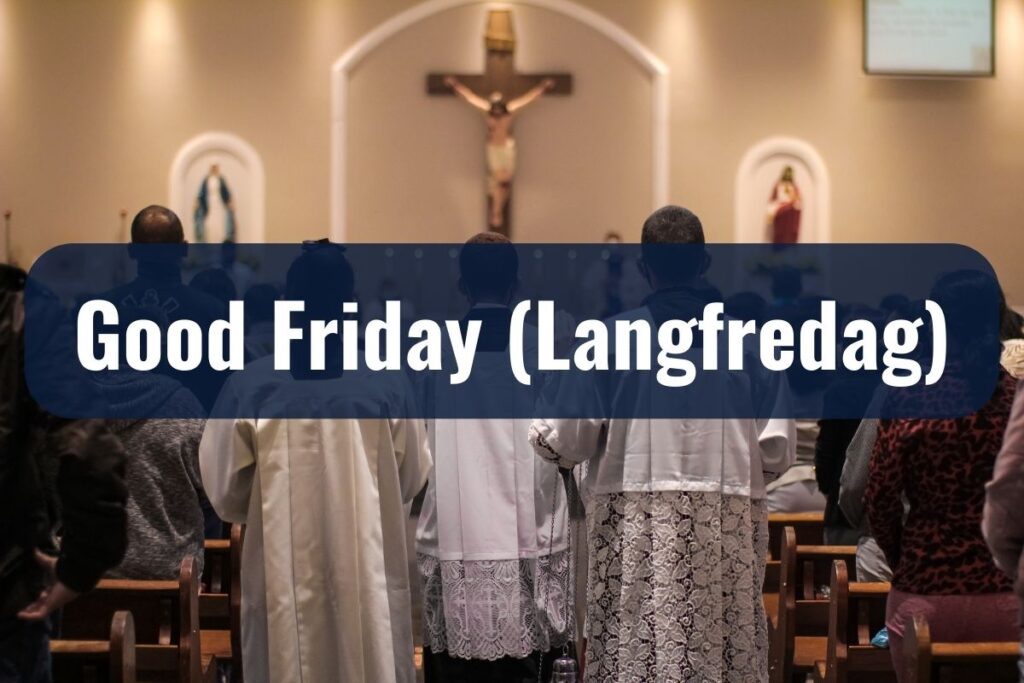
Following Maundy Thursday in the Holy Week is Good Friday, known as ‘Langfredag’ in Norwegian. Falling between Skjærtorsdag and Easter Sunday, its date can vary but typically lands in March or April.
Langfredag is one of the most solemn days in the Christian calendar. It commemorates the crucifixion of Jesus Christ and his subsequent death at Calvary. The ‘good’ in Good Friday may seem contradictory given the somber nature of the day, but it is believed to signify the “holy” or “pious” aspect of the day, reflecting the ultimate sacrifice Jesus made for humanity.
In Norway, Good Friday is observed with deep reverence. Many churches hold special services, often marked by readings from the Gospel accounts of the Passion, moments of silence, and contemplative music. The atmosphere is one of introspection and remembrance, with many Norwegians taking time to reflect on the profound sacrifices and the themes of redemption and forgiveness.
For many in Norway, the day also involves specific traditions. Some might choose to listen to Passion music or watch films and plays depicting the Easter story. Given its status as a public holiday, most businesses and institutions are closed, allowing for a collective pause in daily routines.
Easter Sunday (Første påskedag) and Easter Monday (Andre påskedag)
Easter, known as ‘Påske’ in Norwegian, is a pivotal celebration in the Christian calendar, signifying the resurrection of Jesus Christ from the dead. This momentous event is heralded on Easter Sunday, or ‘Første påskedag’, and is followed by Easter Monday, termed ‘Andre påskedag’. The exact dates for these celebrations vary annually, as they are determined by the lunar calendar, but they generally fall in March or April.
Easter Sunday (Første påskedag)
Easter Sunday is the culmination of the Holy Week, representing hope, renewal, and the triumph of life over death. It is on this day that Christians around the world celebrate Jesus’s resurrection, three days after his crucifixion.
In Norway, Easter Sunday is both a deeply religious and a familial celebration. Churches are adorned with white lilies and other spring flowers, symbolizing purity and new beginnings. Special services, often accompanied by jubilant hymns and music, resonate with messages of hope and joy.
On the home front, many Norwegian families come together for festive meals, often featuring lamb, a symbol of Christ, and other traditional dishes. Easter eggs, representing new life, are a prominent feature. Children often partake in ‘egg hunts’, searching for chocolate or decorated eggs hidden by the adults.
Easter Monday (Andre påskedag)
Following the jubilation of Easter Sunday, Easter Monday provides an extended moment of relaxation and continued celebration. While it might not carry the same religious weight as the preceding day, ‘Andre påskedag’ is a public holiday in Norway, offering residents a day to rest and revel in the lingering festive spirit.
Many Norwegians utilize this day for outdoor activities, especially as the spring weather begins to take hold. It’s not uncommon for families to go for hikes or picnics, embracing the natural beauty Norway has to offer.
Labor Day (Arbeidernes dag) – May 1
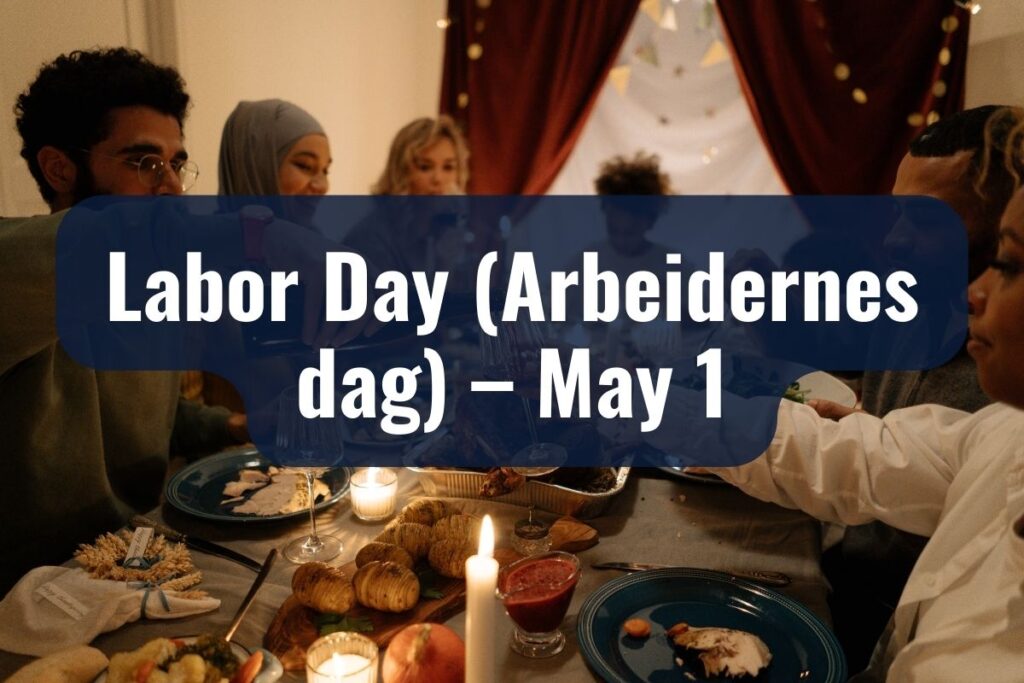
Marking the onset of May is Labor Day, recognized in Norwegian as ‘Arbeidernes dag’. Celebrated annually on the first day of May, it is a day dedicated to honoring workers and acknowledging the importance of workers’ rights and labor movements worldwide.
Originating in the late 19th century, the roots of Labor Day can be traced back to the labor union movement, which advocated for better working conditions, fair wages, and reasonable working hours. While its beginnings were marked by protests and demonstrations, over time, it has evolved into both a day of activism and reflection.
In Norway, Labor Day holds significant importance as a reminder of the nation’s own labor struggles and victories. The day often witnesses organized marches and gatherings in major cities, where labor unions, political parties, and social groups come forward to voice their concerns, celebrate their achievements, and champion for further advancements in workers’ rights.
While the marches and demonstrations underscore the day’s political and activist undertones, for many Norwegians, ‘Arbeidernes dag’ also serves as a moment to appreciate the progress the country has made in creating a fair and just work environment. Schools, businesses, and most public institutions remain closed, allowing for a collective observance of the day.
Constitution Day (Syttende mai) – May 17
One of the most cherished and enthusiastically celebrated holidays in the Norwegian calendar is Constitution Day, fondly known as ‘Syttende mai’ which translates to ‘Seventeenth of May’. As the name suggests, this holiday falls on May 17th and stands as a proud testament to Norway’s journey towards sovereignty and the establishment of its constitution.
On this day in 1814, Norway signed its constitution at Eidsvoll, marking a significant step towards independence from Denmark and laying the foundation for the democratic nation that Norway has become today. While Norway would later enter into a union with Sweden that lasted until 1905, ‘Syttende mai’ celebrates the constitution and the ideals of liberty, independence, and democracy it embodies.
In Norway, Constitution Day is more than just a historic observance; it’s a jubilant national celebration. Here’s what the day typically entails:
Parades and Marches: The heart of the ‘Syttende mai’ celebrations is the children’s parade. With flags in hand, children from schools march through towns and cities, singing national songs and being cheered on by onlookers. In Oslo, the capital, the parade passes the Royal Palace, where the Royal Family acknowledges the procession with waves and smiles.
National Attire: Many Norwegians don their traditional costumes, known as ‘bunad’. These beautifully crafted outfits vary by region and are worn with pride, showcasing the country’s rich cultural tapestry.
Festive Atmosphere: Homes and public buildings are adorned with the Norwegian flag. Families gather for meals, often enjoying traditional foods. Ice creams and hot dogs, surprisingly, have become a modern treat many look forward to on this day.
Concerts and Gatherings: Various events, including concerts, speeches, and games, take place throughout the day, bringing communities together in a spirit of national pride.
Ascension Day (Kristi Himmelfartsdag)
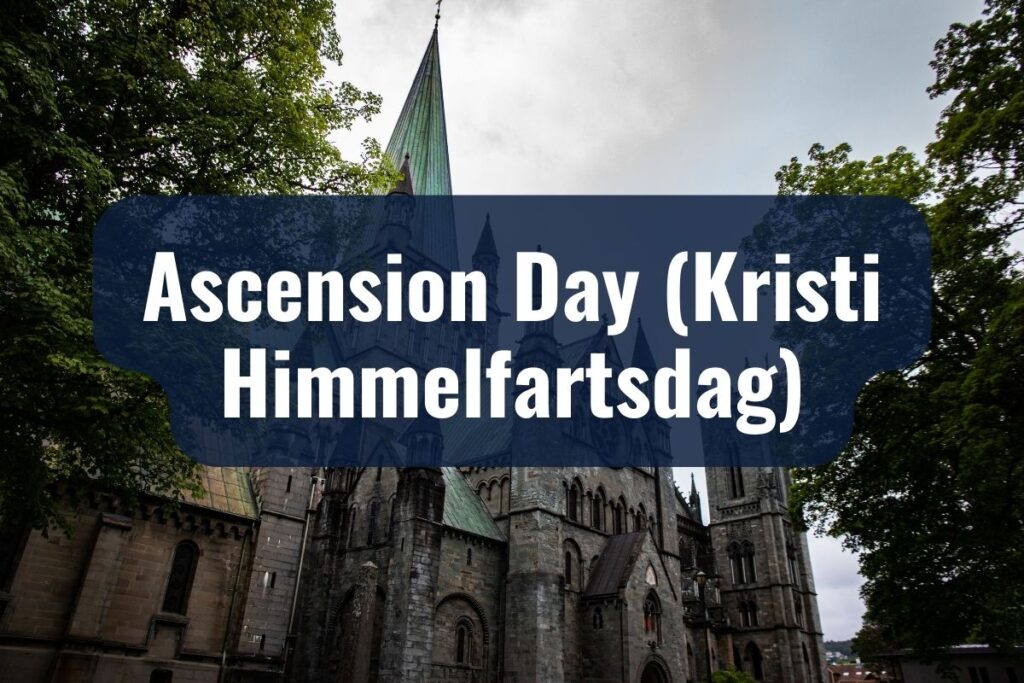
Ascension Day, known as ‘Kristi Himmelfartsdag’ in Norwegian, is another significant Christian observance, commemorating the ascension of Jesus Christ into heaven. This event is believed to have taken place 40 days after Easter Sunday, marking the end of Jesus’ earthly ministry and paving the way for the descent of the Holy Spirit at Pentecost. As such, the date of Ascension Day varies each year, as it is closely tied to the date of Easter.
The importance of Ascension Day lies in its theological implications. For Christians, it signifies Jesus’ triumphant completion of his mission on Earth and his subsequent exaltation in heaven, where he intercedes on behalf of humanity. It’s a day that bridges the joy of the Resurrection at Easter with the anticipation of the Holy Spirit’s arrival, celebrated on Pentecost.
In Norway, Kristi Himmelfartsdag is observed as a public holiday, reflecting the nation’s Christian heritage. Here’s what the day typically involves:
Church Services: Many churches hold special services on Ascension Day, where hymns and sermons revolve around the themes of Jesus’ ascension and its significance for Christian belief. The liturgical color for the day is white, symbolizing purity and joy.
Nature Walks: Given its timing in late spring, many Norwegians take advantage of the public holiday to immerse themselves in nature. Family walks in the countryside or visits to local parks are common, aligning with the uplifting spirit of the day.
Reflection and Prayer: While the festive atmosphere might not be as pronounced as other Christian holidays, many use this day for personal reflection and prayer, contemplating the broader narrative of Jesus’ life, death, resurrection, and ascension.
Pentecost (Pinse)
Following Ascension Day in the Christian liturgical calendar is Pentecost, referred to as ‘Pinse’ in Norwegian. Pentecost is celebrated 50 days after Easter Sunday, culminating the Easter cycle that started with Lent. It commemorates the descent of the Holy Spirit upon the apostles and other followers of Jesus Christ, as described in the New Testament’s Book of Acts.
Pentecost holds a special place in Christian theology as it marks the birth of the Church. The Holy Spirit’s descent symbolizes empowerment, enabling the apostles to preach, perform miracles, and spread the teachings of Christ, thereby laying the foundation for the growth of Christianity.
In Norway, where Christian traditions are deeply woven into the cultural fabric, Pentecost is observed with reverence and reflection. Here’s what the day entails:
Church Services: On Pinse, churches across Norway conduct special services dedicated to the Holy Spirit’s significance and work. Worship often incorporates hymns and prayers seeking the Holy Spirit’s guidance and blessings. The liturgical color for Pentecost is red, representing the fire of the Spirit and the tongues of flame described in the Book of Acts.
Nature and Leisure: Falling in late spring or early summer, Pinse often coincides with pleasant weather. This alignment makes it a favorite time for Norwegians to engage in outdoor activities. Families might choose to spend time in nature, embark on hikes, or indulge in picnics, savoring the onset of the warmer months.
Quiet Contemplation: While Pentecost might not involve grand festivities, its significance encourages many to indulge in personal reflection. Contemplating the Holy Spirit’s role in individual lives and the broader Christian community becomes a profound exercise for many during this time.
Christmas Day (Første juledag) – December 25
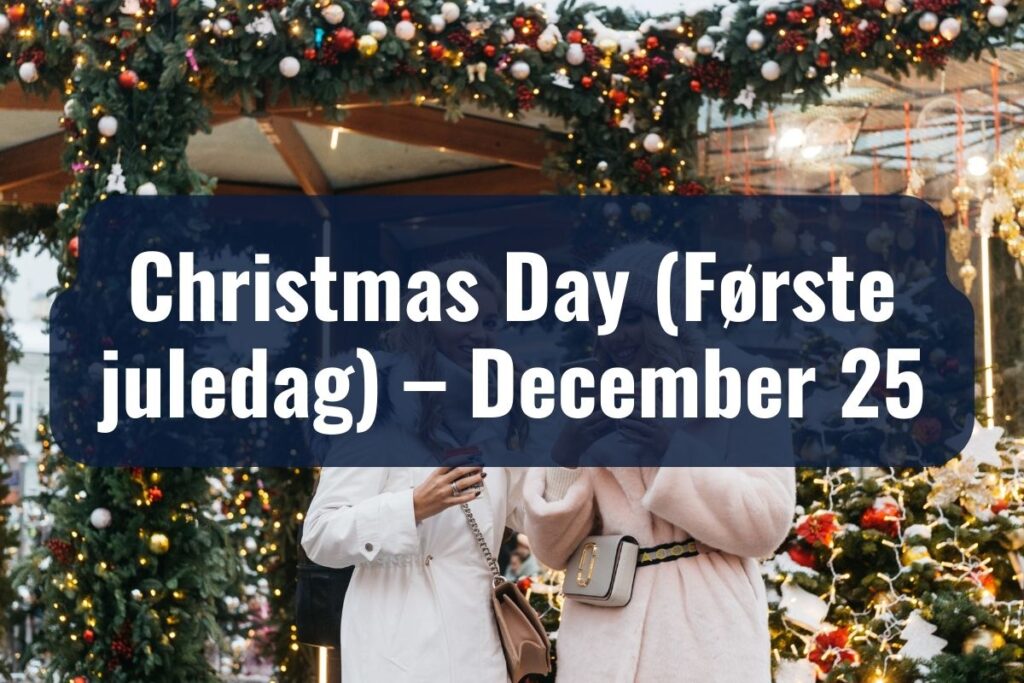
One of the most universally celebrated holidays, Christmas Day, known in Norwegian as ‘Første juledag’, is a day filled with joy, love, and reflection. Falling on December 25th annually, it commemorates the birth of Jesus Christ and represents the hope, peace, and salvation he brought to the world.
In Norway, with its picturesque snow-clad landscapes and long-standing Christian traditions, Christmas Day is celebrated with a unique blend of religious reverence and heartfelt cultural customs. Here’s an insight into how the day unfolds:
Religious Observances
Midnight Mass: The transition from Christmas Eve to Christmas Day is often marked with a Midnight Mass in churches across Norway. These services, filled with candlelight, hymns, and readings from the Gospels, encapsulate the spiritual essence of the holiday.
Daytime Services: On Christmas Day itself, many churches offer services where congregations come together to celebrate the birth of Christ. The atmosphere is one of gratitude and joy, with special hymns and scriptures echoing the story of Jesus’ birth.
Family and Traditions
Festive Meals: After the simplicity of Christmas Eve’s meal, Christmas Day often witnesses a grander feast. Traditional dishes such as ‘ribbe’ (roasted pork belly), ‘pinnekjøtt’ (dried lamb ribs), and ‘lutefisk’ (dried fish reconstituted in a lye solution) might grace the table. These are often accompanied by an assortment of side dishes, desserts, and Christmas treats.
Gift Exchange: While many Norwegian families exchange gifts on Christmas Eve, the joy of gifting often spills over to Christmas Day, especially when extended family or friends come together.
Christmas Carols: Music is an integral part of the celebrations. Families might gather around the fireplace or the Christmas tree, singing carols and reveling in the festive ambiance.
Boxing Day (Andre juledag) – December 26
Following closely on the heels of the grandeur of Christmas Day is Boxing Day, referred to in Norwegian as ‘Andre juledag’, which translates to ‘Second Day of Christmas’. Unlike some countries where Boxing Day might involve massive sales or a focus on materialistic pursuits, in Norway, it retains a quieter, more reflective character, allowing the spirit of Christmas to linger a little longer.
Here’s a closer look at how Boxing Day is observed in the heart of Norway:
Continuation of Family Gatherings
Extended Family Celebrations: While Christmas Day is often reserved for immediate family, Boxing Day provides an opportunity for extended family members to come together. It’s a time to catch up, share stories, and indulge in the festive spirit.
Leftover Feasts: The grand meals of Christmas Day inevitably lead to leftovers, and Boxing Day becomes the perfect occasion to relish them. It’s common for families to concoct creative dishes using leftover meats and sides or simply warm up the festive treats for another round of feasting.
Leisure and Nature
Outdoor Activities: The crisp winter air of Norway beckons many outdoors on Boxing Day. Activities like skiing, sledding, or taking a peaceful walk through snow-covered landscapes become a favorite pastime, allowing families to bond while enjoying Norway’s natural beauty.
Rest and Relaxation: After the bustling preparations and celebrations of Christmas Day, many Norwegians use Boxing Day as a day of rest. It’s a time to relax, read, play board games, or simply enjoy the warmth of home.
Cultural and Community Engagements
Concerts and Events: Some communities or cultural organizations might host special concerts, plays, or events on Boxing Day, keeping the festive spirit alive and offering entertainment for those keen to step out.
Related: Facts About Norway: Your Guide to the Norwegian Life
Other Notable Public Holidays in Norway
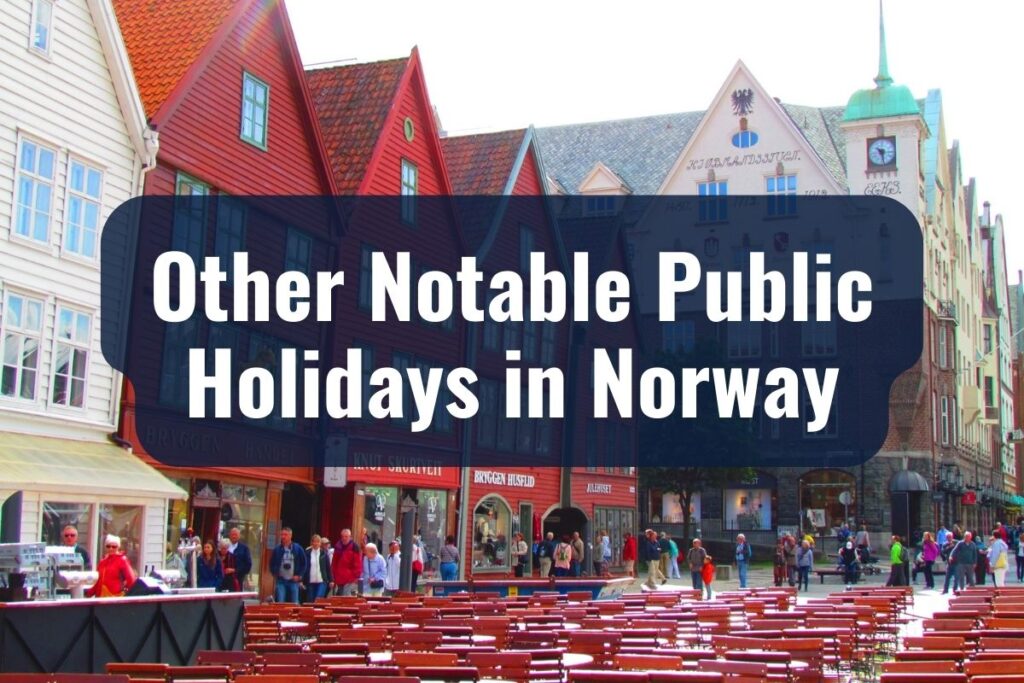
While the aforementioned public holidays hold a significant place in the Norwegian calendar, there are other days, not necessarily public holidays, that resonate with cultural, historical, or seasonal importance in Norway. While they might not involve official closures or grand celebrations, understanding these days provides a fuller picture of Norwegian life and traditions.
St. Lucia’s Day (Luciadagen) – December 13
Before Christmas festivities take full swing, there’s a charming celebration called St. Lucia’s Day. Rooted in ancient and Christian traditions, it’s a festival of light celebrated in the darkest time of the year. Young girls, dressed in white gowns with red sashes and wearing a crown of candles, lead processions in schools, kindergartens, and local communities, singing the Lucia song. The atmosphere is serene and filled with anticipation for the Christmas season ahead.
Midsummer’s Eve (Sankthansaften) – June 23
Celebrated on the eve of St. John the Baptist’s day, Midsummer’s Eve, or ‘Sankthansaften’, is a welcoming of the summer season. As the days are long and nights are short, Norwegians gather for bonfires, singing, and dancing. The bonfire, a central element, symbolizes the power of the sun and is believed to ward off evil spirits.
Mother’s Day (Morsdag) – Second Sunday of February
While not unique to Norway, Mother’s Day is celebrated with warmth and affection. Families express gratitude to their mothers with gifts, flowers, breakfast in bed, or simply by spending quality time together. It’s a day that underscores the importance of family bonds in Norwegian culture.
Father’s Day (Farsdag) – Second Sunday of November
Similar to Mother’s Day, Father’s Day in Norway is an occasion to honor and appreciate the role of fathers. Whether through gifts, activities, or heartfelt gestures, it’s a day to strengthen family ties and acknowledge the contributions of fathers.
Valentine’s Day (Valentinsdagen) – February 14
Gradually gaining popularity in Norway, Valentine’s Day is often marked by the exchange of gifts, flowers, and cards between loved ones. While not rooted deeply in Norwegian tradition, it’s a day that many, especially the younger generation, embrace as an expression of love and affection.


